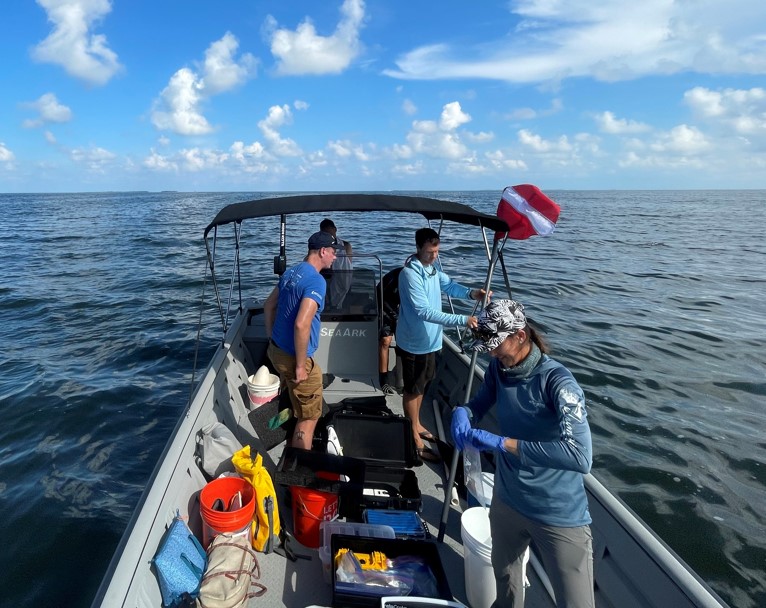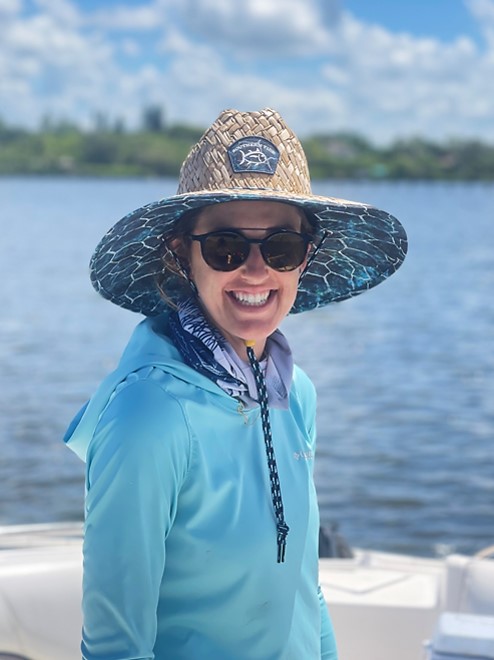Amanda Chappel, an Environmental Engineering Sciences PhD student in Dr. Elise Morrison’s lab, is studying the ecosystem effects of coastal eutrophication and its implications on nutrient cycling dynamics in estuarine systems, with the goal of supporting effective management strategies that will advance solutions to minimize anthropogenic impacts to coastal systems. We asked Amanda to tell us a bit about her background, what motivates her, and what she aims to accomplish with her dissertation.
Background
 As a Florida native, my career has been driven by a lifelong connection to Florida’s coastal waters and diverse habitats. My earlier research was immersed in understanding coastal ecosystem dynamics to help prioritize mitigation and restoration efforts for coastal ecosystems. I received my Bachelor and Master of Science degrees from the University of South Florida (USF) in Environmental Science in 2015 and 2018, respectively. While in graduate school, I held a teaching assistant position in the Organic Chemistry Laboratory and was a Scientific Researcher with the Florida Fish and Wildlife Conservation Commission’s Coastal Wetland Program at the Research Institute (FWRI). The positions I held with FWRI, and USF greatly complemented one another as they both focused on coastal research, but also sought to address different research questions throughout southwest Florida. Briefly, my research experience spans the following major research themes: (1) quantifying blue carbon to determine coastal wetlands’ contribution to the global carbon budget; (2) evaluating the ecosystem effects of sea level rise (SLR) and climate change on wetland soil biogeochemistry and using soil core chronologies as a proxy for SLR; (3) assessing short- and long-term impacts of anthropogenic development and natural disasters on mangrove forests; (4) mapping and monitoring coastal habitats state-wide including mangroves, salt marshes, salt barrens, oyster reefs and seagrass beds, which resulted in collaborative statewide reports to identify gaps in mapping and monitoring; (5) establish recruitment rates of mangroves into created and restored salt marsh systems to enhance restoration efforts; (6) water sampling in the Tampa Bay estuary to better understand nutrient cycling and ocean acidification processes; (7) establishing long-term water quality monitoring datasets to investigate carbon cycling dynamics in areas influenced by coastal development and associated runoff.
As a Florida native, my career has been driven by a lifelong connection to Florida’s coastal waters and diverse habitats. My earlier research was immersed in understanding coastal ecosystem dynamics to help prioritize mitigation and restoration efforts for coastal ecosystems. I received my Bachelor and Master of Science degrees from the University of South Florida (USF) in Environmental Science in 2015 and 2018, respectively. While in graduate school, I held a teaching assistant position in the Organic Chemistry Laboratory and was a Scientific Researcher with the Florida Fish and Wildlife Conservation Commission’s Coastal Wetland Program at the Research Institute (FWRI). The positions I held with FWRI, and USF greatly complemented one another as they both focused on coastal research, but also sought to address different research questions throughout southwest Florida. Briefly, my research experience spans the following major research themes: (1) quantifying blue carbon to determine coastal wetlands’ contribution to the global carbon budget; (2) evaluating the ecosystem effects of sea level rise (SLR) and climate change on wetland soil biogeochemistry and using soil core chronologies as a proxy for SLR; (3) assessing short- and long-term impacts of anthropogenic development and natural disasters on mangrove forests; (4) mapping and monitoring coastal habitats state-wide including mangroves, salt marshes, salt barrens, oyster reefs and seagrass beds, which resulted in collaborative statewide reports to identify gaps in mapping and monitoring; (5) establish recruitment rates of mangroves into created and restored salt marsh systems to enhance restoration efforts; (6) water sampling in the Tampa Bay estuary to better understand nutrient cycling and ocean acidification processes; (7) establishing long-term water quality monitoring datasets to investigate carbon cycling dynamics in areas influenced by coastal development and associated runoff.
Following completion of the graduate program at USF, I continued as an Associate Researcher with USF’s Biogeochemistry Laboratory and held a Certified Ecologist position in the Environmental Services Department at Stantec, an engineering consulting firm. This position included involvement with projects in groundwater and ecological monitoring, habitat and coastal restoration, native habitat assessments, and listed species surveys. Holding a position as a practitioner with the engineering firm provided great perspective on scientific application in a constantly changing and developing society and made me aware of the many disconnects that still exist between researchers, regulators, and practitioners. Accordingly, a goal of my dissertation research with Dr. Morrison at the University of Florida and Center for Coastal Solutions is to build collaborations that will facilitate management strategies to minimize anthropogenic impacts on aquatic critical zones (ACZs).
Motivation
Over the past seven years, I have been immersed in both scientific research and environmental monitoring and permitting. These experiences provided a valuable perspective on environmental management and engineering. That is, effective management strategies and regulations need collaboration amongst the scientific community, regulatory agencies, and industry. Without this collaboration, impediments in imperative management can occur. Developing scientific findings into focused objectives to guide strategies that will advance solutions to minimize anthropogenic impacts to coastal communities is an immense undertaking. Further, management strategies for a constantly changing world need persistent scrutiny and adaptation for success. Thus, research that extends outside of the scientific community to promote broader impacts on societal adaptation and collaboration is essential. Without these efforts, impediments turn into pitfalls, which can progress into environmental catastrophes.
 This summer, I experienced first-hand the impacts that humans can have on coastal systems. When red tide blooms saturated Tampa and Sarasota Bay, resulting in fish kills and impaired water quality, I was motivated to further investigate these topics with my PhD research with the goal of contributing to management solutions. In recent decades, wastewater spills and industrial waste releases of high-nutrient contaminated waters have become chronic stressors on nearshore environments, often driven by the failure of engineering systems. In April 2021, structural failures in the Piney Point phosphogypsum stack prompted the controlled release of approximately 215 million gallons of nitrogen- and phosphorous-rich discharge water into Tampa Bay, Florida. Phosphogypsum is the by-product of the chemical processing of phosphate rock to make fertilizer, which, if not properly managed, can pose serious threats to local watersheds. Upon release of the effluent from Piney Point, multiple institutions, including the University of Florida’s (UF) Center for Coastal Solutions (NSF RAPID 2130675; PI Morrison, co-PI Phlips), Tampa and Sarasota Bay Estuary Programs (TBEP and SBEP, respectively), Florida Department of Environmental Protection (FDEP), and county partners, promptly began examining water quality and assessing community composition of the local macroalgae, phytoplankton and seagrass communities. Preliminary findings and in-field observations throughout the summer of 2021 found high-concentration blooms of red tide (Karenia brevis) and cyanobacteria (Dapis spp., formerly Lyngbya spp.), hypoxic zones, and fish kills throughout both Tampa and Sarasota Bay, all which appeared interconnected. However, quantifying the extent to which these events may be related to the Piney Point discharge is still an active research challenge.
This summer, I experienced first-hand the impacts that humans can have on coastal systems. When red tide blooms saturated Tampa and Sarasota Bay, resulting in fish kills and impaired water quality, I was motivated to further investigate these topics with my PhD research with the goal of contributing to management solutions. In recent decades, wastewater spills and industrial waste releases of high-nutrient contaminated waters have become chronic stressors on nearshore environments, often driven by the failure of engineering systems. In April 2021, structural failures in the Piney Point phosphogypsum stack prompted the controlled release of approximately 215 million gallons of nitrogen- and phosphorous-rich discharge water into Tampa Bay, Florida. Phosphogypsum is the by-product of the chemical processing of phosphate rock to make fertilizer, which, if not properly managed, can pose serious threats to local watersheds. Upon release of the effluent from Piney Point, multiple institutions, including the University of Florida’s (UF) Center for Coastal Solutions (NSF RAPID 2130675; PI Morrison, co-PI Phlips), Tampa and Sarasota Bay Estuary Programs (TBEP and SBEP, respectively), Florida Department of Environmental Protection (FDEP), and county partners, promptly began examining water quality and assessing community composition of the local macroalgae, phytoplankton and seagrass communities. Preliminary findings and in-field observations throughout the summer of 2021 found high-concentration blooms of red tide (Karenia brevis) and cyanobacteria (Dapis spp., formerly Lyngbya spp.), hypoxic zones, and fish kills throughout both Tampa and Sarasota Bay, all which appeared interconnected. However, quantifying the extent to which these events may be related to the Piney Point discharge is still an active research challenge.
Dissertation Research Goals
 As a PhD student in Dr. Elise Morrison’s lab my research is focused on the ecosystem effects of coastal eutrophication and its implications on nutrient cycling dynamics in estuarine systems, with the goal of supporting effective management strategies that will advance solutions to minimize anthropogenic impacts to coastal systems. More specifically, my proposed research will quantify the effects of eutrophication on primary producers and evaluate the fate of the anthropogenic waste released from Piney Point through the use of isotopic markers to inform adaptive water quality management strategies. By conducting additional research both temporally and spatially, to build on preliminary monitoring efforts, I will address the following research questions: 1) what effects do anthropogenic disturbances have on primary producers; 2) what is the fate of anthropogenic wastewater when discharged into aquatic critical zones? After investigating the impacts of anthropogenic disturbances on primary producers and evaluating down-core changes in isotope signatures, I will evaluate the relationship between eutrophication and trophic-state changes in ACZs. This research will link coastal biogeochemistry and environmental engineering to advance knowledge in fields ranging from applied coastal ecosystem dynamics to ACZs sustainability and management. These research objectives focus on applying novel approaches into functional frameworks to quantify the effects of anthropogenic disturbances on coastal resources that are economically and ecologically essential to the sustainability of coastal communities.
As a PhD student in Dr. Elise Morrison’s lab my research is focused on the ecosystem effects of coastal eutrophication and its implications on nutrient cycling dynamics in estuarine systems, with the goal of supporting effective management strategies that will advance solutions to minimize anthropogenic impacts to coastal systems. More specifically, my proposed research will quantify the effects of eutrophication on primary producers and evaluate the fate of the anthropogenic waste released from Piney Point through the use of isotopic markers to inform adaptive water quality management strategies. By conducting additional research both temporally and spatially, to build on preliminary monitoring efforts, I will address the following research questions: 1) what effects do anthropogenic disturbances have on primary producers; 2) what is the fate of anthropogenic wastewater when discharged into aquatic critical zones? After investigating the impacts of anthropogenic disturbances on primary producers and evaluating down-core changes in isotope signatures, I will evaluate the relationship between eutrophication and trophic-state changes in ACZs. This research will link coastal biogeochemistry and environmental engineering to advance knowledge in fields ranging from applied coastal ecosystem dynamics to ACZs sustainability and management. These research objectives focus on applying novel approaches into functional frameworks to quantify the effects of anthropogenic disturbances on coastal resources that are economically and ecologically essential to the sustainability of coastal communities.